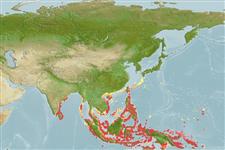>
Acanthuriformes (Surgeonfishes) >
Pomacanthidae (Angelfishes)
Etymology: Chaetodontoplus: Greek, chaite = hair + Greek, odous = teeth + Greek, plous, ous, oo = crossing (Ref. 45335).
More on author: Bloch.
Environment: milieu / climate zone / depth range / distribution range
Écologie
marin récifal; non migrateur; profondeur 1 - 20 m (Ref. 9710). Tropical; 36°N - 12°S, 78°E - 167°E
Indo-West Pacific: Japan to Indonesia, Sri Lanka and east to Papua New Guinea (Ref. 4859). Reported from Mentawai Islands (Ref. 27157). May consist of two separate species, one with an all-yellow tail and the other mostly gray tail (Ref. 48391).
Taille / Poids / Âge
Maturity: Lm ? range ? - ? cm
Max length : 18.0 cm TL mâle / non sexé; (Ref. 9710)
Épines dorsales (Total): 12; Rayons mous dorsaux (Total): 17-18; Épines anales 3; Rayons mous anaux: 17 - 18.
Inhabits continental shelf reefs; not usually found around oceanic islands (Ref. 9710). Feeds on sponges, tunicates, and filamentous algae (Ref. 9710). Forms small groups. Frequently exported through the aquarium trade (Ref. 48391). Very close to Chaetodontoplus poliourus Randall & Rocha, 2009 with different colors on pelvic, dorsal and caudal fins. The two species coexist in several islands of Indonesia (Ref. 82330) including Lesser Sunda Islands, Molucca Islands, Halmahera, and Bird's Head Peninsula of West Papua (Ref. 90102).
Life cycle and mating behavior
Maturité | Reproduction | Frai | Œufs | Fécondité | Larves
Protogyny has been proposed for this species awaiting confirmation (Ref. 103751).
Myers, R.F., 1991. Micronesian reef fishes. Second Ed. Coral Graphics, Barrigada, Guam. 298 p. (Ref. 1602)
Statut dans la liste rouge de l'IUCN (Ref. 130435)
Menace pour l'homme
Harmless
Utilisations par l'homme
Pêcheries: intérêt commercial mineur; Aquarium: Commercial
Plus d'informations
RéférencesAquacultureProfil d'aquacultureSouchesGénétiqueElectrophoresesHéritabilitéPathologiesTraitementNutrientsMass conversion
Outils
Articles particuliers
Télécharger en XML
Sources Internet
Estimates based on models
Preferred temperature (Ref.
123201): 25.5 - 29, mean 28.7 °C (based on 1472 cells).
Phylogenetic diversity index (Ref.
82804): PD
50 = 0.5000 [Uniqueness, from 0.5 = low to 2.0 = high].
Bayesian length-weight: a=0.03090 (0.01359 - 0.07026), b=2.89 (2.70 - 3.08), in cm total length, based on LWR estimates for this (Sub)family-body shape (Ref.
93245).
Niveau trophique (Ref.
69278): 2.7 ±0.00 se; based on food items.
Résilience (Ref.
120179): Milieu, temps minimum de doublement de population : 1,4 à 4,4 années (Preliminary K or Fecundity.).
Fishing Vulnerability (Ref.
59153): Low vulnerability (10 of 100).
Nutrients (Ref.
124155): Calcium = 74.2 [37.9, 119.1] mg/100g; Iron = 0.627 [0.385, 1.027] mg/100g; Protein = 18.2 [17.0, 19.3] %; Omega3 = 0.0986 [, ] g/100g; Selenium = 23.4 [13.2, 43.4] μg/100g; VitaminA = 84.4 [22.9, 291.9] μg/100g; Zinc = 1.58 [1.08, 2.27] mg/100g (wet weight);
